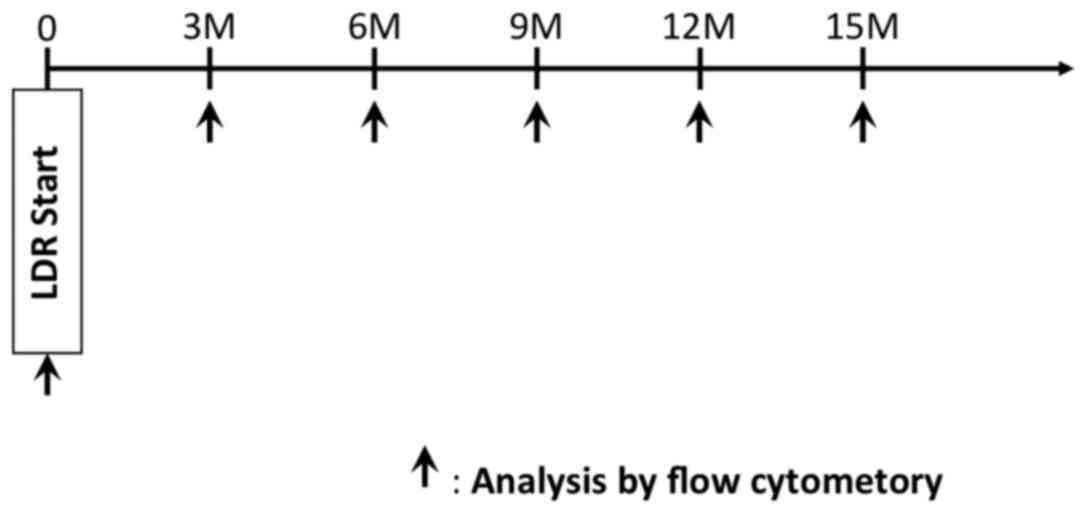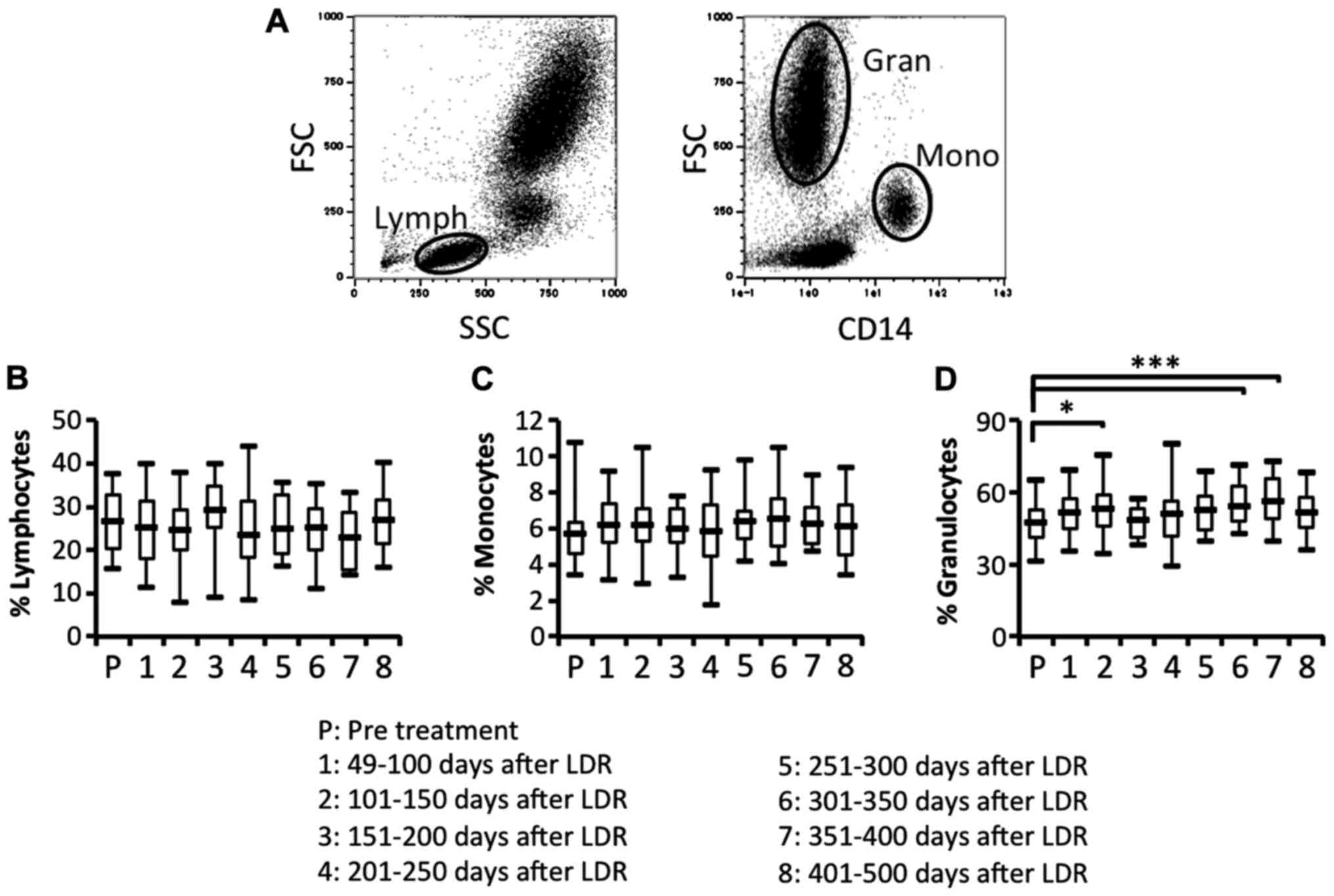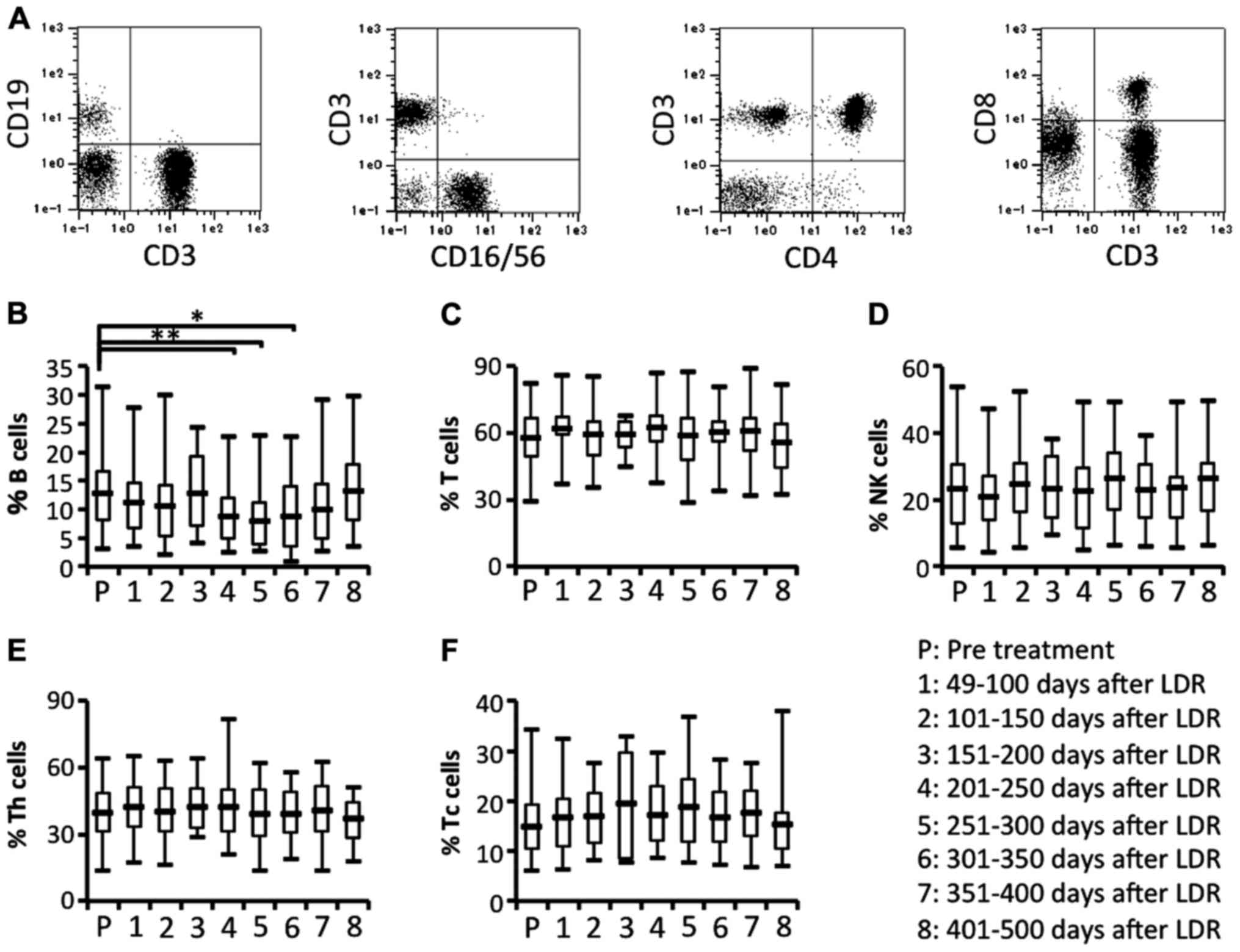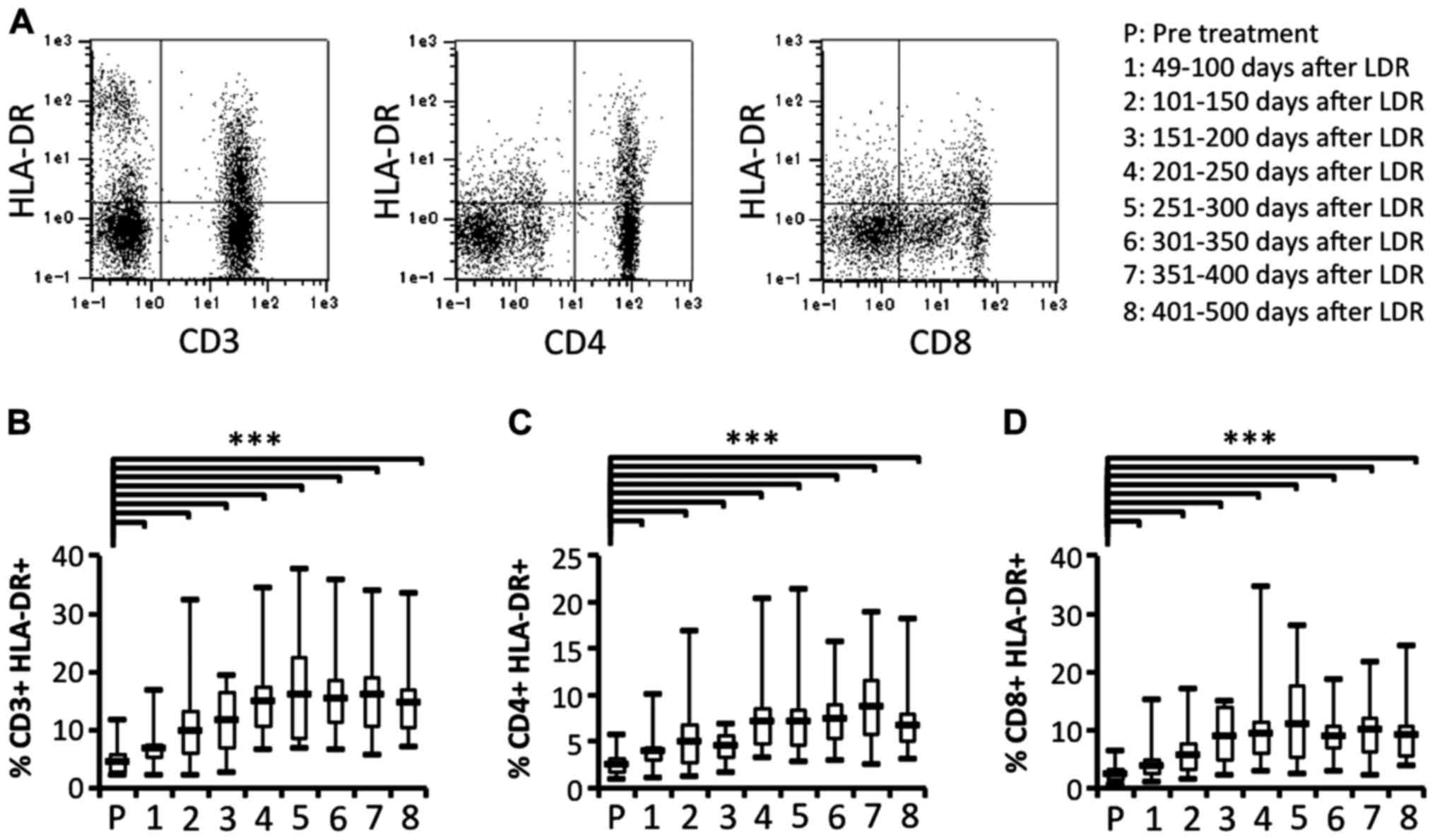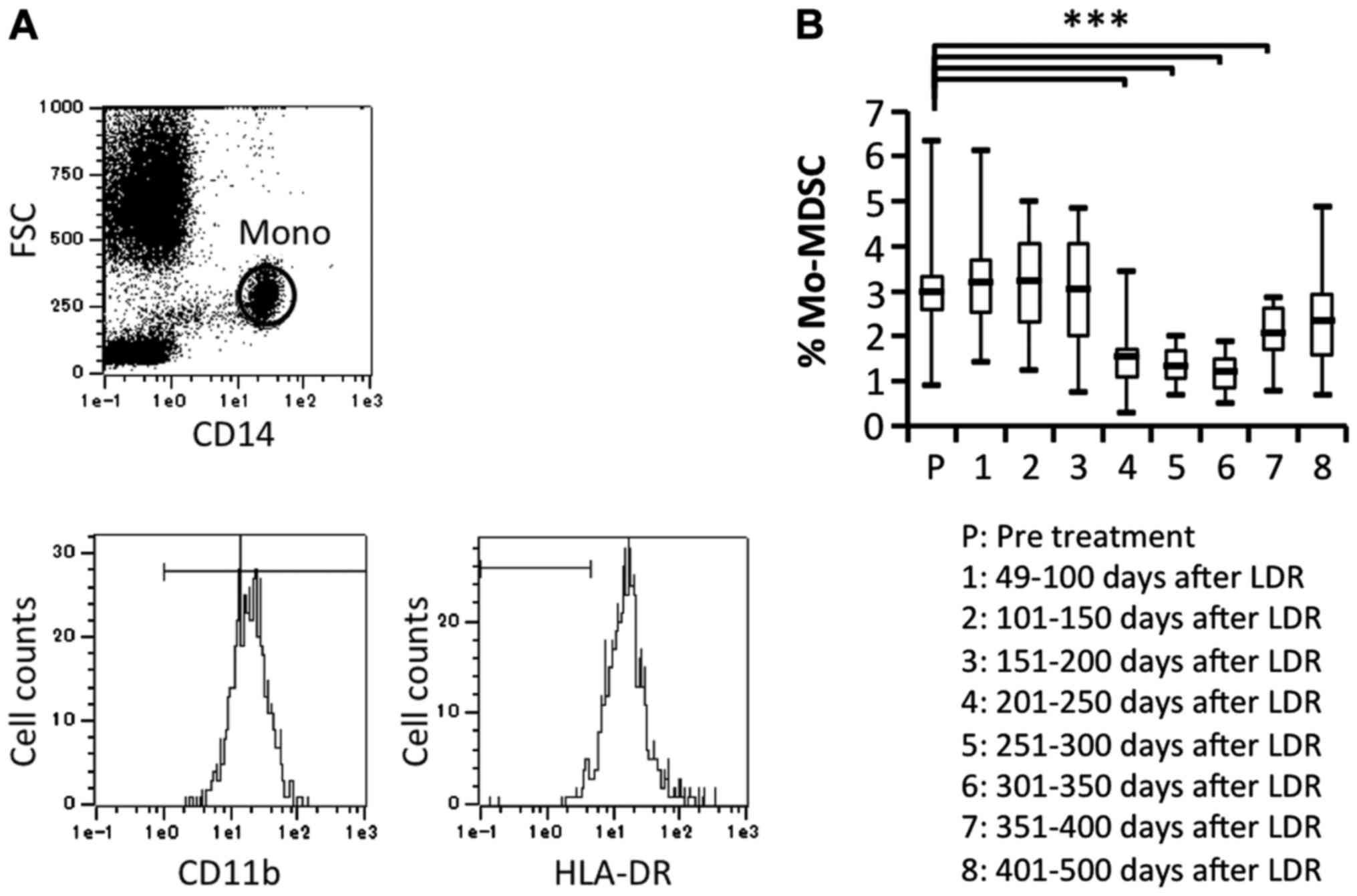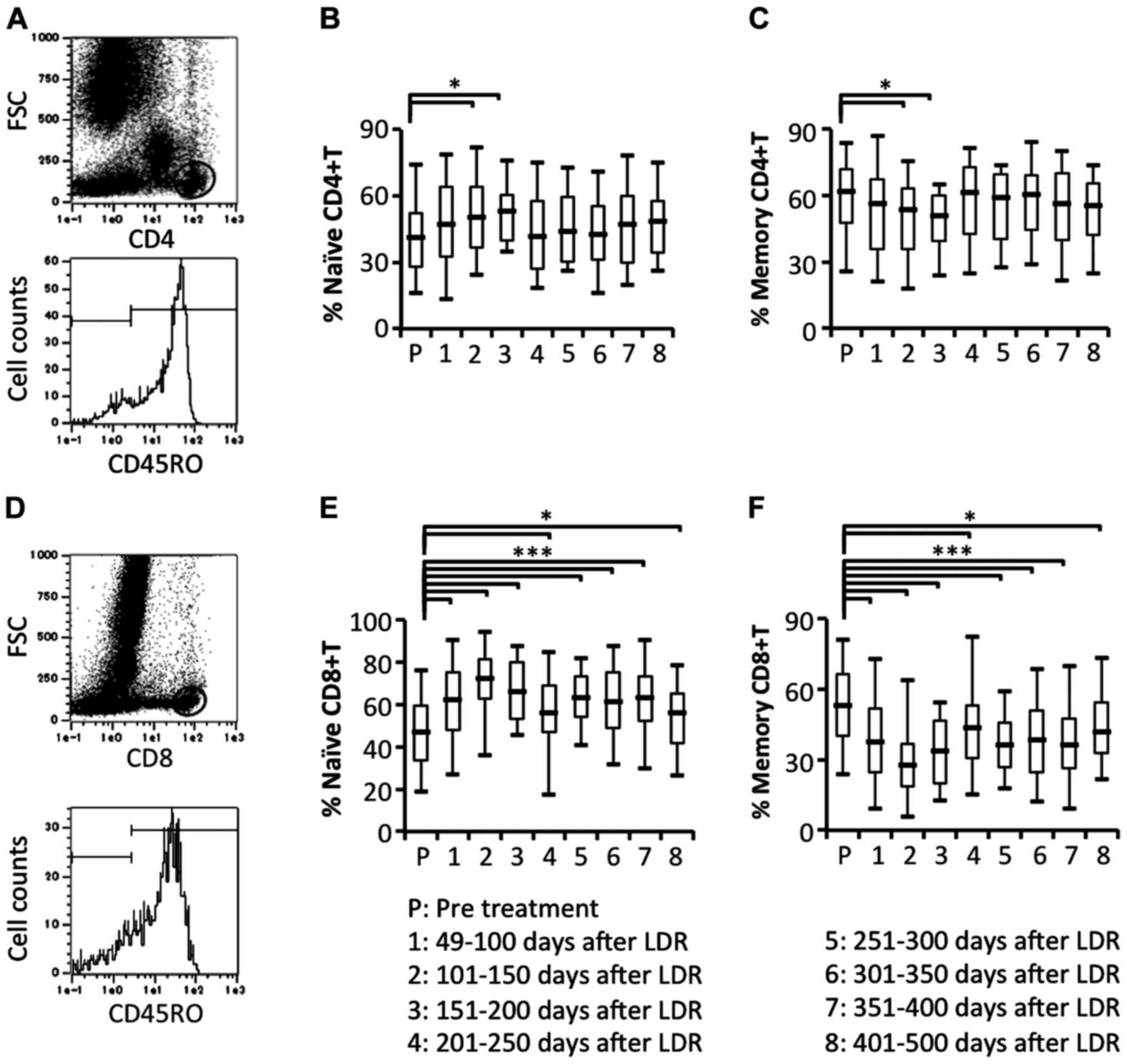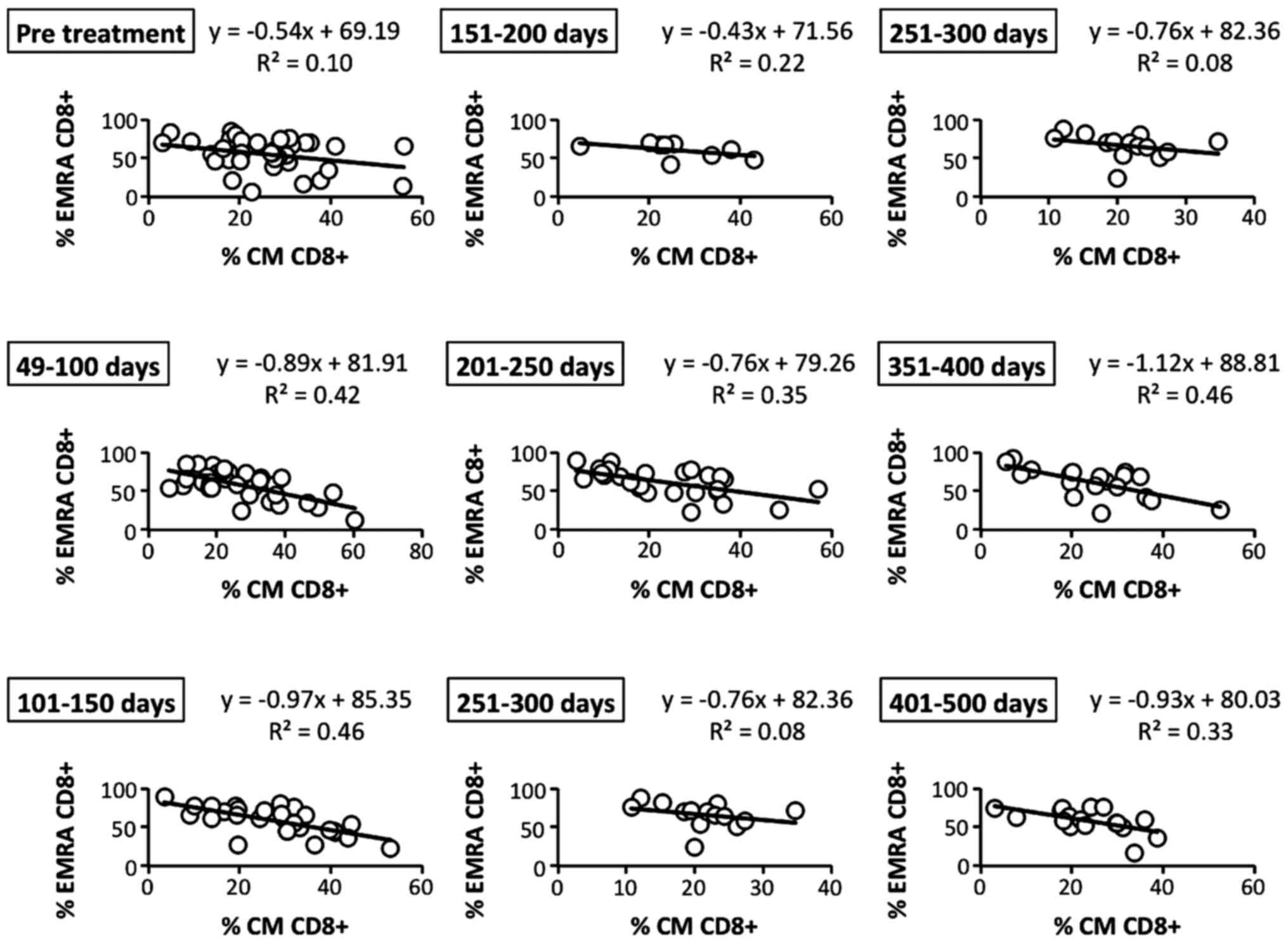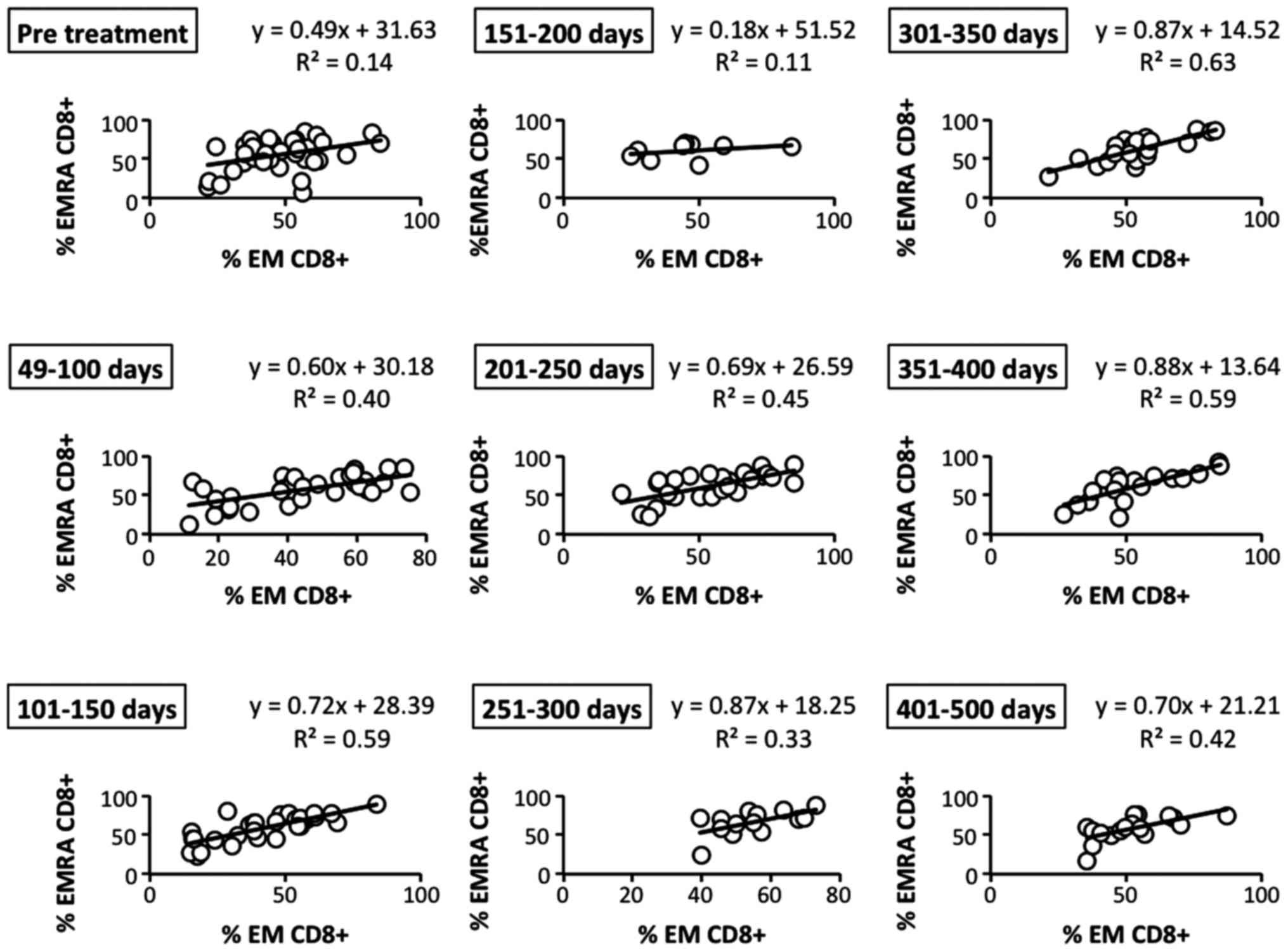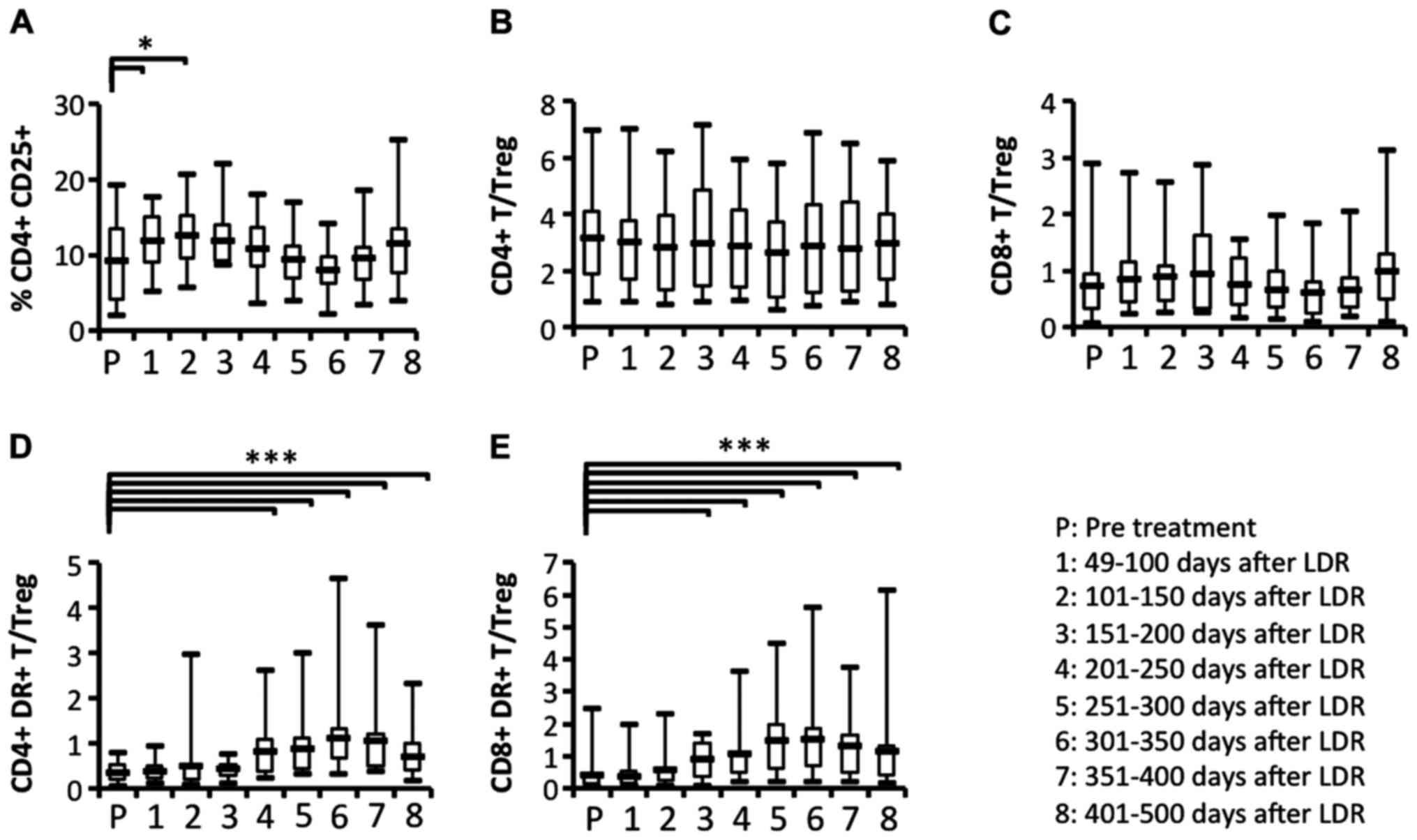Enhanced activated T cell subsets in prostate cancer patients receiving iodine-125 low-dose-rate prostate brachytherapy
- Authors:
- Published online on: November 13, 2017 https://doi.org/10.3892/or.2017.6095
- Pages: 417-424
Abstract
Introduction
The efficacy of prostate cancer (PCa) detection based on the serum level of prostate-specific antigen (PSA) coupled with the use of ultrasound-guided random systematic prostate biopsy has led to a marked improvement in diagnostic accuracy and treatment. However, PCa morbidity and mortality rates have also increased markedly in Japan and other countries.
The effectiveness of radiotherapy (RT) in particular has improved as a result of the development and introduction of computer software and treatment devices. RT is currently a standard treatment for various malignant tumors, including those of the breast, lung and prostate. RT for PCa can be classified as external beam RT or brachytherapy. The former includes intensity-modulated radiation therapy (IMRT), 3-dimensional conformal radiation therapy (3D-CRT) and stereotactic radiotherapy (SRT), whereas the latter includes iridium-192 high-dose-rate (HDR) and iodine-125 low-dose-rate (LDR) brachytherapy. Permanent iodine-125 LDR brachytherapy is one of the important curative treatments currently available for localized PCa. Either HDR or LDR brachytherapy can deliver a high dose rate to the prostate parenchyma in comparison with external irradiation treatments (1).
RT for localized PCa may directly kill tumor cells. Clinically, however, patients receiving RT occasionally show an abscopal effect whereby not only local, but also distant tumors regress after localized irradiation (2). It has been reported that treatment-associated autoantibodies were detectable in 29.2% (7 of 24), 13.8% (4 of 29), 25% (5 of 20) and 5.6% (2 of 36) of PCa patients who had undergone neoadjuvant hormone therapy, external beam RT, brachytherapy and radical prostatectomy, respectively (3). It has also been reported that patients who had received RT exhibited an increased count of survivin-specific cytotoxic CD8+ T cells (4). In a pre-clinical study of cancer-bearing mice, Takeshima et al found that the efficacy of tumor reduction by RT declined after CD8+ T cell depletion (5). Although RT may induce some immune responses, the details are still not clear. Irradiation has been revealed to induce many immunomodulators from apoptotic and necrotic tumor cells, including tumor-associated antigens, heat shock proteins (HSPs), high mobility group box 1 (HMGB1), and adenosine triphosphate (ATP) (6,7). These immunomodulators can activate immature dendritic cells (DCs), which in turn may enhance inflammatory responses and activate T cells, including tumor antigen-specific T cells.
As aforementioned, permanent I-125 LDR brachytherapy is an important curative treatment for localized PCa. We consider that LDR may initiate continuous immune stimulation through gradual disruption of the prostate parenchyma by the LDR seed implant. In the present study, therefore, to clarify the immune responses of PCa patients receiving LDR brachytherapy, we studied the dynamics of leukocyte subsets in peripheral blood altered before and after the treatment.
Materials and methods
Patients
The present study subjects were 36 patients with clinically localized PCa who underwent I-125 brachytherapy. The patients characteristics are shown in Table I. All of the patients gave study-specific informed consent, which was approved by the Institutional Review Board for Observation and Epidemiological Study (KMEO B13-62). The present study approved by the Kitasato University Medical Ethics Organization
Leukocytes immunophenotyping
The immunophenotyping was monitored approximately every ~3 months (Fig. 1). EDTA-2Na-treated whole blood (100 µl) was incubated with the following fluorescence-conjugated monoclonal antibodies (MAbs) against the following: CD1c (PE/Cy7; cat. no. 331516), CD4 (PE/Cy7; cat. no. 317414), CD8 (APC/Cy7; cat. no. 344714), CD11b (PE; cat. no. 301306), CD14 (PerCP/Cy5.5; cat. no. 301824), CD15 (PE/Cy7; cat. no. 323030), CD25 (FITC; cat. no. 302604), CD45RA (Pacific Blue; cat. no. 304123), CD45RO (APC; cat. no. 304210), CD62L (FITC; cat. no. 104406), CD66b (FITC; cat. no. 305104), CD141 (APC; cat. no. 344106), CCR7 (PE; cat. no. 353204), HLA-DR (PerCP/Cy5.5 and APC/Cy7) (cat. nos. 307630 and 307618) (all from BioLegend, San Diego, CA, USA) CD3/CD16/56 (FITC/PE; Becton-Dickinson, San Jose, CA, USA), and mouse IgG1 (Pacific Blue, FITC-PE-PE/Cy5 cocktail, PE/Cy7, APC and APC/Cy7; cat. nos. 400151, 319201, 400125, 400119 and 400127; BioLegend). After incubation at room temperature for 15 min, red blood cells were lysed with BD FACS lysing solution (Becton-Dickinson, San Jose, CA). FSC and SSC were set to distinguish the lymphocyte, macrophage, and granulocyte populations from debris with a MACSQuant flow cytometer (Miltenyi Biotec GmbH, Bergish Gladbach, Germany). Multi-color immunofluorescence analysis was performed using 10,000 lymphocytes for each analysis.
Statistical analysis
Statistical significance was analyzed using the Student's t-test. Differences were considered statistically significant at P<0.05.
Results
Comparison of circulating leukocyte subsets before and after LDR brachytherapy
To study the efficacy of the immune responses, we investigated whether the proportion of lymphocytes, monocytes and granulocytes in peripheral blood was affected by the LDR brachytherapy. We then compared the proportion of lymphocytes, monocytes and granulocytes in peripheral blood before and after the therapy (Fig. 2A-D). The proportion of lymphocytes and monocytes before and after LDR brachytherapy did not differ (Fig. 2B and C). In contrast, the proportion of granulocytes was significantly and bimodally increased after LDR brachytherapy (Fig. 2D). To investigate the difference in lymphocyte subsets, we next compared the proportion of lymphocyte subsets before and after LDR brachytherapy. The proportions of T cells (CD3+CD19− cells gated on lymphocytes) and natural killer (NK) cells (CD3−CD16/56+ cells gated on lymphocytes) did not significantly differ before and after LDR brachytherapy (Fig. 3A, C and D). In contrast, the proportion of B cells (CD3−CD19+ cells gated on lymphocytes) was significantly and bimodally decreased after the therapy (Fig. 3A and B). We also analyzed the proportion of T cell subsets. The proportion of helper T cells (CD3+CD4+ cells gated on lymphocytes) and killer T cells (CD3+ CD8+ cells gated on lymphocytes) before and after LDR brachytherapy did not differ significantly (Fig. 3A, E and F). These results revealed that granulocytes may be increased in peripheral blood due to the induction of inflammatory responses in the irradiated PCa, and that B cells may be depleted from peripheral blood due to migration of antigen-recognizing B cells from peripheral blood to the irradiated PCa.
Comparison of circulating activated T cell subsets and monocyte-derived suppressor cells before and after LDR brachytherapy
To clarify whether activated T cell subsets were effectively induced, we next investigated the activation of T cell subsets in patients who had received LDR brachytherapy. We also compared the proportion of activated T cell subsets before and after LDR brachytherapy. The proportion of activated T cell subsets (CD3+HLA-DR+, CD4+HLA-DR+ and CD8+ HLA-DR+) were significantly and gradually increased after LDR brachytherapy (Fig. 4). Previous studies have indicated that RT used against cancer can induce myeloid-derived suppressor cells (MDSCs), which can suppress immune responses by producing inhibitory cytokines. Therefore, we investigated the proportion of MDSCs (CD11b+CD14+HLA-DR− gated on monocytes) before and after LDR brachytherapy and found that MDSCs were significantly decreased after 201 days of LDR brachytherapy (Fig. 5A and B). This suggested that the immune responses induced by LDR brachytherapy may gradually activate both CD4+ and CD8+ T cell subsets, whereas reduction of MDSCs may affect T cell activation.
Comparison of circulating naïve and memory T cell subsets
To study the details of naïve and memory T cell responses in patients who had received LDR brachytherapy, we examined the proportion of circulating naïve (CD45RO− gated on CD4+ or CD8+ cells) and memory (CD45RO+ gated on CD4+ or CD8+ cells) T cell subsets. Naïve CD4+ T cells were significantly increased at an early stage after the start of LDR brachytherapy. In contrast to naïve CD4+ T cells, memory CD4+ T cells were significantly decreased at an early stage after the start of LDR brachytherapy (Fig. 6A-C). In contrast, naïve CD8+ T cells were significantly and bimodally increased and memory CD8+ T cells were significantly and bimodally decreased (Fig. 6D-F). These results demonstrated that memory CD4+ and CD8+ T cells were effectively induced to migrate from blood vessels to the local prostate environment.
Correlations among circulating memory CD8+ T cell subsets
To further study the details of memory CD8+ T cell subsets in patients who had received LDR brachytherapy, we analyzed the correlation of central memory (CM) with effector memory (EM) CD8+ T cells before and after LDR brachytherapy. After the therapy, the inverse correlation of CM (CD45RO+ CD62L+ CCR7+) with EMRA (CD45RO− CD62L− CCR7−) CD8+ T cells became gradually and bimodally higher than before the therapy (Fig. 7). In contrast, we observed that the positive correlation of EM and EMRA (CD45RO− CD62L− CCR7−) CD8+ T cells, another EM subset, was gradually and bimodally increased after the therapy (Fig. 8). These results revealed that effector memory CD8+ T cells, which play an important role in the antitumor immune response, may be effectively induced by LDR brachytherapy.
Comparison of the circulating regulatory T cell (Treg) ratio relative to activated T cell subsets
Our results indicated that some immune responses, including the activation of T cell subsets, appeared to be evident from the start of LDR brachytherapy until ~200 days later. The proportion of the Treg subset was significantly increased after the start of LDR brachytherapy (Fig. 9A). To determine whether Treg cells were affected by the induction of activated T cell subsets, we analyzed the ratios of T cell subsets or activated T cell subsets relative to Treg. The ratios of CD4+ and CD8+ T cell subsets relative to Tregs did not change significantly during the observation period (Fig. 9B and C). In contrast, we observed that the ratios of activated CD4+ and CD8+ T cell subsets relative to Tregs were significantly increased at ~200 days after the start of LDR brachytherapy (Fig. 9D and E). These results revealed that the increase in activated T cell subsets may affect the reduction of the Treg subset induced by LDR brachytherapy.
Discussion
Radiotherapy (RT) is a standard treatment for prostate cancer. Clinically, although RT directly induces cancer cell killing, an abscopal effect whereby regression of distant tumors occurs following local irradiation is occasionally observed (2). However, details of the mechanisms involved and the induced immune responses in prostate cancer (PCa) patients who received RT have not been well defined. In the present study, we investigated in detail the dynamics of systemic leukocyte subsets before and after RT, and found that activated T cells subsets and effector memory CD8+ T cells were efficiently increased in patients who received LDR brachytherapy.
With regard to the relationship between RT and immune responses, Stone et al revealed that immunosuppressed thymectomized mice require more than twice the radiation dose for control of fibrosarcoma in comparison with normal syngeneic mice (8). Moreover, in cancer-bearing mice, Takeshima et al reported that the efficacy of tumor rejection induced by RT decreased after CD8+ T cell depletion (5). Furthermore, in mice inoculated with EL4 lymphoma cells, local irradiation successfully controlled EL4 tumor growth and the mice survived. The mice then rejected the tumor after re-inoculation of EL4 lymphoma cells (9). Several clinical studies have demonstrated an abscopal effect of RT whereby distant metastatic tumors are rejected or decreased following localized irradiation (2,10). Although this abscopal effect is an infrequent phenomenon, it has recently been reported in patients who have undergone RT coupled with immunotherapies such as inoculation with toll-like receptor (TLR) agonists, anti-transforming growth factor β (TGFβ), anti-CD152 (CTLA-4) and anti-programmed death-1 (PD-1) receptor antibodies (11,12). CTLA-4 and PD-1 have received notable attention as important immune checkpoint molecules. As aforementioned, the antitumor efficacy by RT is considered to be closely associated with the induction of immune responses. However, the immune responses in patients who have received RT are not well defined. In particular, the alterations in the immune responses of patients receiving LDR brachytherapy have never been previously reported.
In the present study, we found that activated T cell subsets were significantly and gradually increased after LDR brachytherapy. Although the precise mechanism responsible for this T cell-subset activation was not clear, an inverse reduction of MDSCs and regulatory T cells (Tregs) may be involved. Kachikwu et al reported that radiation treatment increased the population of Tregs in mice (13). We also observed that Tregs were significantly increased after 150 days of LDR brachytherapy, as compared with the situation before RT. Although our findings were partly consistent with theirs, we also observed a tendency for Treg reduction after 200 days of LDR brachytherapy. Wu et al indicated that splenic MDSCs were increased in prostate tumor-bearing mice 48 h after radiation (14). Although we did not observe an increase of MDSCs after LDR brachytherapy, we recognized a significant reduction in the ratio of MDSCs at 200 days after the start of LDR brachytherapy. Certain factors may influence the populations of Tregs and MDSCs. Xu et al has reported that blockade of macrophage colony-stimulating factor (CSF1) signaling improves the efficacy of RT for PCa (15). Therefore there is a need to investigate cytokines and chemokines in the plasma of patients before and after LDR brachytherapy.
We also observed that naïve T cells in peripheral blood were bimodally and significantly increased after LDR brachytherapy, whereas memory T cells were decreased. These results suggest that memory T cells, particularly memory CD8+ T cells, may infiltrate from the peripheral blood to the irradiated PCa, leading to a relative increase of naïve T cells in peripheral blood. However, Tabi et al previously reported that the proportion of apoptotic and Fas+ naïve (CD45RA+) T cells was increased in patients who received external beam radiotherapy (EBRT) (16). Our findings were inconsistent with their results. LDR brachytherapy may have limited influence on the immune system due to internal localized irradiation. In the present study, we found that some leukocyte subsets in patients who received LDR brachytherapy were dynamically and sequentially changed. In the future, to demonstrate the role of activated T cells and regulatory cells in remission and relapse rates, we will endeavor to compare overall survival rates, relapse rates, and T cell activation in PCa patients receiving LDR brachytherapy. Although we observed some dynamic immune responses in LDR patients, we did not investigate details of the immune response in patients who received other radiotherapies, including HDR. In the next step, a comparison of the immune responses of patients who have received other treatments is warranted.
In conclusion, we have shown for the first time that the proportion of activated T cell subsets in peripheral blood was gradually and significantly increased after LDR brachytherapy. In contrast, the proportion of Tregs and Mo-MDSCs was significantly decreased after 200 days of LDR brachytherapy. The increase of activated T cell subsets resulting from LDR brachytherapy may help to maintain remission and reduce relapse rates. The decrease of Tregs and Mo-MDSCs may be related to the increase of activated T cell subsets.
Acknowledgements
The present study was supported by the JSPS KAKENHI grant nos. C25462500 and 16K11028, and grants from the Kitasato University School of Allied Health Sciences (Grant-in-aid for Research Project 2012-2014).
References
|
Ishiyama H, Satoh T, Kawakami S, Tsumura H, Komori S, Tabata K, Sekiguchi A, Takahashi R, Soda I, Takenaka K, et al: A prospective quasi-randomized comparison of intraoperatively built custom-linked seeds versus loose seeds for prostate brachytherapy. Int J Radiat Oncol Biol Phys. 90:134–139. 2014. View Article : Google Scholar : PubMed/NCBI | |
|
Twyman-Saint Victor C, Rech AJ, Maity A, Rengan R, Pauken KE, Stelekati E, Benci JL, Xu B, Dada H, Odorizzi PM, et al: Radiation and dual checkpoint blockade activate non-redundant immune mechanisms in cancer. Nature. 520:373–377. 2015. View Article : Google Scholar : PubMed/NCBI | |
|
Nesslinger NJ, Sahota RA, Stone B, Johnson K, Chima N, King C, Rasmussen D, Bishop D, Rennie PS, Gleave M, et al: Standard treatments induce antigen-specific immune responses in prostate cancer. Clin Cancer Res. 13:1493–1502. 2007. View Article : Google Scholar : PubMed/NCBI | |
|
Schaue D, Comin-Anduix B, Ribas A, Zhang L, Goodglick L, Sayre JW, Debucquoy A, Haustermans K and McBride WH: T-cell responses to survivin in cancer patients undergoing radiation therapy. Clin Cancer Res. 14:4883–4890. 2008. View Article : Google Scholar : PubMed/NCBI | |
|
Takeshima T, Chamoto K, Wakita D, Ohkuri T, Togashi Y, Shirato H, Kitamura H and Nishimura T: Local radiation therapy inhibits tumor growth through the generation of tumor-specific CTL: Its potentiation by combination with Th1 cell therapy. Cancer Res. 70:2697–2706. 2010. View Article : Google Scholar : PubMed/NCBI | |
|
Ma Y, Kepp O, Ghiringhelli F, Apetoh L, Aymeric L, Locher C, Tesniere A, Martins I, Ly A, Haynes NM, et al: Chemotherapy and radiotherapy: Cryptic anticancer vaccines. Semin Immunol. 22:113–124. 2010. View Article : Google Scholar : PubMed/NCBI | |
|
Gameiro SR, Jammeh ML, Wattenberg MM, Tsang KY, Ferrone S and Hodge JW: Radiation-induced immunogenic modulation of tumor enhances antigen processing and calreticulin exposure, resulting in enhanced T-cell killing. Oncotarget. 5:403–416. 2014. View Article : Google Scholar : PubMed/NCBI | |
|
Stone HB, Peters LJ and Milas L: Effect of host immune capability on radiocurability and subsequent transplantability of a murine fibrosarcoma. J Natl Cancer Inst. 63:1229–1235. 1979.PubMed/NCBI | |
|
Yoshimoto Y, Suzuki Y, Mimura K, Ando K, Oike T, Sato H, Okonogi N, Maruyama T, Izawa S, Noda SE, et al: Radiotherapy-induced anti-tumor immunity contributes to the therapeutic efficacy of irradiation and can be augmented by CTLA-4 blockade in a mouse model. PLoS One. 9:e925722014. View Article : Google Scholar : PubMed/NCBI | |
|
Ludgate CM: Optimizing cancer treatments to induce an acute immune response: Radiation abscopal effects, PAMPs, and DAMPs. Clin Cancer Res. 18:4522–4525. 2012. View Article : Google Scholar : PubMed/NCBI | |
|
Marabelle A, Filatenkov A, Sagiv-Barfi I and Kohrt H: Radiotherapy and toll-like receptor agonists. Semin Radiat Oncol. 25:34–39. 2015. View Article : Google Scholar : PubMed/NCBI | |
|
Fernández-García EM, Vera-Badillo FE, Perez-Valderrama B, Matos-Pita AS and Duran I: Immunotherapy in prostate cancer: Review of the current evidence. Clin Transl Oncol. 17:339–357. 2015. View Article : Google Scholar : PubMed/NCBI | |
|
Kachikwu EL, Iwamoto KS, Liao YP, DeMarco JJ, Agazaryan N, Economou JS, McBride WH and Schaue D: Radiation enhances regulatory T cell representation. Int J Radiat Oncol Biol Phys. 81:1128–1135. 2011. View Article : Google Scholar : PubMed/NCBI | |
|
Wu CT, Chen MF, Chen WC and Hsieh CC: The role of IL-6 in the radiation response of prostate cancer. Radiat Oncol. 8:159–169. 2013. View Article : Google Scholar : PubMed/NCBI | |
|
Xu J, Escamilla J, Mok S, David J, Priceman S, West B, Bollag G, McBride W and Wu L: CSF1R signaling blockade stanches tumor-infiltrating myeloid cells and improves the efficacy of radiotherapy in prostate cancer. Cancer Res. 73:2782–2794. 2013. View Article : Google Scholar : PubMed/NCBI | |
|
Tabi Z, Spary LK, Coleman S, Clayton A, Mason MD and Staffurth J: Resistance of CD45RA- T cells to apoptosis and functional impairment, and activation of tumor-antigen specific T cells during radiation therapy of prostate cancer. J Immunol. 185:1330–1339. 2010. View Article : Google Scholar : PubMed/NCBI |



